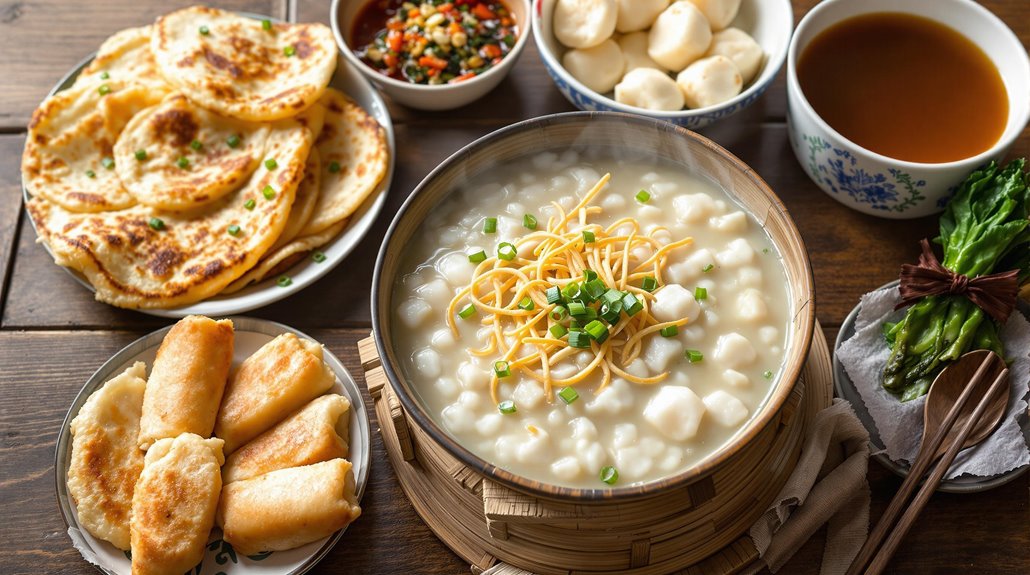Physical Address
304 North Cardinal St.
Dorchester Center, MA 02124
Physical Address
304 North Cardinal St.
Dorchester Center, MA 02124

Chinese breakfast favorites reimagined with vegetarian flair - from congee to baozi - bring comfort and tradition to your morning table.
Five classic Chinese vegetarian breakfast dishes will start your day with nourishing comfort: warm congee topped with crispy shallots, pan-fried tofu-stuffed pancakes with dipping sauces, garden vegetable noodle soup rich with bok choy and mushrooms, steamed vegetable baozi filled with cabbage and shiitake, and crispy you tiao paired with fresh soy milk. These traditional dishes offer satisfying flavors and textures while keeping true to vegetarian principles. Each recipe holds centuries of cultural heritage waiting to be explored.
When you're craving a comforting Chinese breakfast that's both nourishing and vegetarian-friendly, congee delivers with its creamy, porridge-like consistency and endless topping possibilities.
You'll start with jasmine rice simmered in vegetable or vegan chicken broth, enhanced with aromatic garlic, ginger, and lemongrass. The rice-to-liquid ratio ranges from 1:6 to 1:9, depending on your preferred thickness. The dish takes less than 5 minutes to begin cooking, making it an efficient morning option.
Fragrant jasmine rice transforms into silky comfort food when simmered with aromatics in a generous bath of flavorful broth.
To elevate your congee, add shiitake mushrooms for umami depth, and consider mixing in corn, zucchini, or sweet potato.
Don't forget the essential crispy toppings: fried shallots, toasted sesame seeds, and a drizzle of chili oil provide delightful textural contrast.
If you're short on time, try the Instant Pot method, which cuts cooking time to just 30 minutes while maintaining the dish's signature silky texture.
Three delightful layers make these golden pan-fried tofu stuffed pancakes a standout Chinese breakfast option: a crispy exterior, tender dough, and a savory filling that'll make you forget it's meat-free.
You'll create the pliable dough using all-purpose flour, warm water, salt, and oil, letting it rest for ideal elasticity before rolling it into 5-6 inch wrappers. Enhance the texture of your pancakes by heating the skillet thoroughly before adding any ingredients.
For the filling, you'll combine crumbled tofu (seasoned with turmeric and black salt for an egg-like flavor) with shredded carrots, scallions, and bell peppers.
After pleating and sealing the edges, pan-fry your pancakes in neutral oil until golden-brown, adding a splash of water to steam the interiors.
Serve them with your choice of dipping sauces: soy-vinegar blend, chili crisp, or peanut sauce.
Moving from stuffed pancakes to something lighter yet equally satisfying, a steaming bowl of Chinese noodle soup offers the perfect start to your morning.
Adding white miso paste enhances the savory depth of this breakfast favorite.
You'll discover comfort in the aromatic broth, which combines vegetable stock, soy sauce, and fresh ginger, while nutritious vegetables like bok choy, mushrooms, and carrots provide essential vitamins and fiber.
Choose your noodles wisely – shirataki keeps it light at 29g of carbs, while traditional wheat noodles offer heartier satisfaction.
Selecting the right noodles transforms your soup – go light with shirataki or embrace the satisfying fullness of classic wheat options.
For the best results, you'll want to sauté garlic and ginger first to build flavor, then add your vegetables in stages.
Start with firm vegetables, saving leafy greens for last.
Don't forget to cook your noodles separately to maintain their perfect texture.
Customize the heat level with sriracha or balance flavors with a splash of lime juice.
Among China's beloved breakfast offerings, steamed vegetable baozi distinguishes itself as a pillowy-soft bun filled with aromatic vegetables and seasonings.
You'll discover these dumplings packed with a flavorful mixture of shredded cabbage, shiitake mushrooms, and carrots, all enhanced by fragrant ginger and garlic. The dough requires careful kneading and proofing for 1-3 hours to achieve its characteristic texture. Traditional recipes use plain all-purpose flour as the base for the perfect dough consistency.
Before assembling your baozi, you'll want to stir-fry the filling ingredients with sesame oil, soy sauce, and Shaoxing wine to develop deep umami flavors.
Remember to pre-cook your vegetables to prevent excess moisture from making the buns soggy. Once you've pleated the buns closed, steam them for 10-12 minutes until they're perfectly tender.
For added texture, try pan-frying the bottoms for a crispy finish.
The unbeatable combination of crispy You Tiao and freshly made soy milk stands as China's most cherished plant-based breakfast pairing.
You'll discover this iconic duo at street vendors before dawn, where the golden-brown dough sticks emerge piping hot from bubbling oil, ready to be dunked in smooth, unsweetened soy milk. The airy and chewy texture of properly made You Tiao creates an irresistible contrast of crunch and tenderness.
To make authentic You Tiao at home, you'll need to prepare a simple dough using flour, baking powder, salt, and water, then let it rest overnight for the perfect texture.
When you're ready to cook, heat oil to 375°F and fry until golden.
For the soy milk, blend soaked soybeans with water in a 1:10 ratio, strain, and gently boil.
You can enjoy this protein-rich breakfast the traditional way or try modern variations like air-fried versions for a healthier twist.
These five Chinese vegetarian breakfast dishes bridge ancient tradition with modern plant-based eating, offering you nourishing ways to start your day. While congee and you tiao represent timeless comfort foods that have warmed generations, creative additions like pan-fried tofu pancakes show how classic techniques can evolve. Whether you're a longtime vegetarian or simply exploring meatless options, these recipes prove that Chinese breakfast can be both satisfying and sustainable.